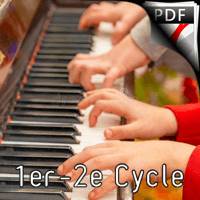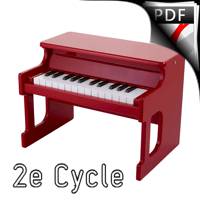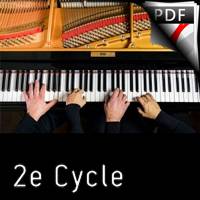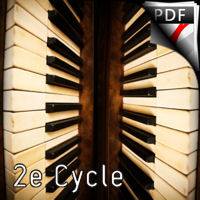Download your PDF score!
By music teachers, for their students
| Title | Author | Set | Prices | ||
|---|---|---|---|---|---|

|
Fleur de lotus |
Lucie Libourel |
Piano 4 mains |
7.90€ |
|

|
9 pièces pour piano 4 mains |
José Schmeltz |
Piano 4 mains |
19.90€ |
|

|
Baby Mozart |
Denis Burel |
Piano 4 Mains |
7.90€ |
|

|
Like a Ludwig sonata |
Denis Burel |
Piano 4 Mains |
7.90€ |
|

|
20 doigts pour 1 ragtime (20 fingers for 1 ragtime) |
Denis Burel |
Piano 4 Mains |
7.90€ |
|

|
Balade Arc-en-ciel |
Rose-Marie Jougla |
Piano 4 mains |
19.90€ |
|

|
Basin Street Blues |
Spencer Williams |
Piano 4 mains |
7.90€ |
|

|
La Vague et l'Ocean |
Denis Burel |
Piano 4 mains |
7.90€ |
Piano four hands (English: Piano four hands, German: Zu vier Händen, Vierhändig, Italian: quattro mani) is a kind of piano duet in which both musicians play the same piano. A duet with musicians playing separate instruments is usually called a piano duet.
Music written for piano four hands is usually printed so that the part for each musician occupies the page directly opposite it. The top part, for the pianist sitting on the right with the music on the right side of the page, is called primo, while the bottom part, for the pianist sitting on the left, is called secondo.
Most of the "four-hand" music is composed of arrangements of orchestral and vocal compositions and quartets and other ensembles for string instruments. Indeed, there is hardly any important composition for a combination of instruments that has not been arranged and published in this form, which, because of its comparative ease of performance, is calculated to be comparative ease of performance, is calculated to reproduce the characteristic effects of these works more easily and faithfully than arrangements for piano alone. Sometimes organ works and works for two-handed piano with advanced difficulty have also been arranged for four-handed piano, in order to make them accessible to amateurs. Such arrangements were particularly popular before the development of recording technology, as the vast majority of the time there was no other way to hear many of the best-known musical works.
The first known printed works for the four-handed fortepiano were published in Dessau around 1782, under the title Drey Sonaten füre Clavier als Doppelstücke fur zwey Personen mit vier Handen von C. H. Müller. Prior to this, Ernst Wilhelm Wolf, music director of Weimar in 1761, had written one or more sonatas for two performers, which were published after his death. As far as is known, these are the first compositions of this kind, although the idea of using two performers (but not on one instrument) may have originated with Johann Sebastian Bach, who wrote three concertos for two harpsichords, three for three and one for four, all accompanied by string instruments. But the small range of the keyboard, which in Bach's time and until about 1770 never exceeded five octaves, was not suitable for theBut the small range of the keyboard, which at the time of Bach and until about 1770 never exceeded five octaves, was not suitable for the combination of two players on the same instrument, and this is probably why earlier composers have left so little music of the same kind.
Haydn and Beethoven seem to have had little interest in this instrumentation. According to Fétis, Haydn wrote only one "four-hand" score, an entertainment that was never published (two other sonatas published under his name, op. 81 and 86, are spurious). Beethoven left only one sonata, op. 6, three marches, op. 45, and two sets of variations, none of which are of great importance. Mozart's work in this area is more important. Of Mozart's nine fortepiano duets, two, the Adagio and Allegro in F minor and the Fantasy in F minor, were originally written for mechanical organ at an exhibition in Vienna and then arranged for piano by an unknown hand; of the others, the Vienna sonatas KV 497 and KV 521 stand out.
Among the best-known composers, Schubert made the most of the original effects on music for four hands. His compositions include the Sonata in C major for piano four hands, D 812, the Divertissement à la hongroise, D 818, and Fantasia in F minor for piano four hands, D 940. In addition, he wrote fourteen marches, six polonaises, four sets of variations, three rondos, a sonata, a set of dances and four separate pieces.
Of the German Romantic composers, the four-hand works of Schumann and Brahms are the most interesting. Mendelssohn wrote only one original work of this kind, although he himself arranged some of his orchestral works in this form, as well as his Octet and the Variations in B flat major for piano, Op. 83. In addition to writing a number of small pieces for two performers, Schumann experimented in a novel and successful way with his Spanish Liebeslieder (op. 138), which consists of ten pieces for four voices, including songs, duets and a quartet, with four-hand piano accompaniment. A similar idea was later realized by Brahms, who wrote two sets of waltzes for four hands and four voices (Liebeslieder Walzer, op. 52, and Neue Liebeslieder, op. 65). Among his instrumental pieces for four hands, the best known is 16 Waltzes, Op. 39. A well-known piece by a French romantic composer is Fauré's Suite Dolly.
